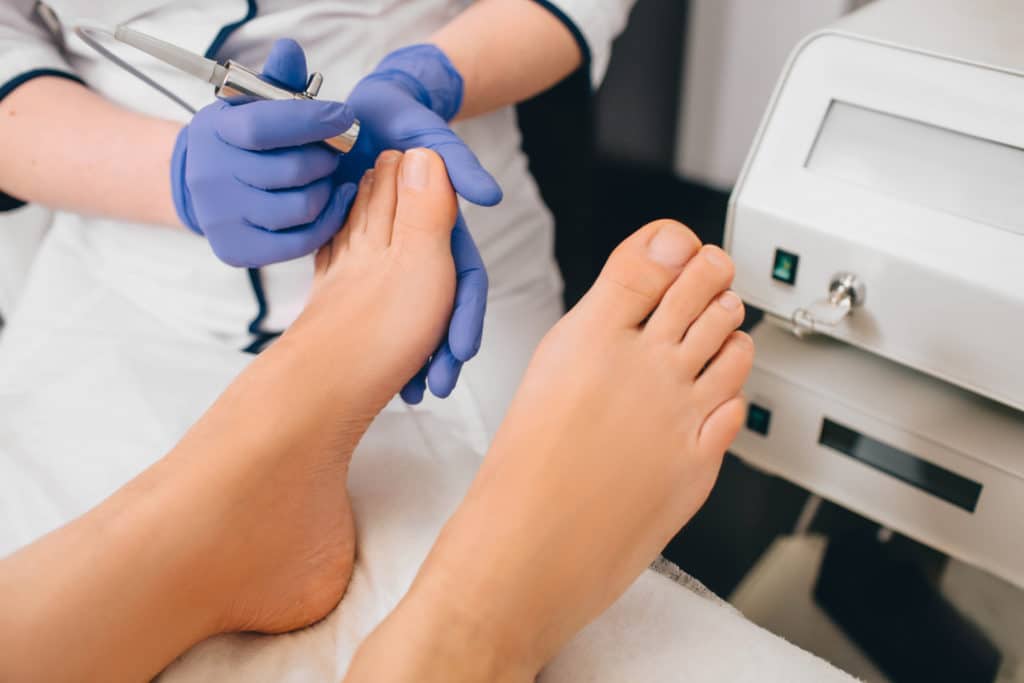If you’ve noticed a sudden change in the appearance or feel of one or more of your toenails, a fungal infection may be to blame. While a toenail infection does not necessarily need to be treated, it is important to know that there are several available treatment options and it is a relatively common condition that millions encounter every year.
What Causes Toenail Infections?
Onychomycosis, or fungal infection of the toes or fingernails, occurs when fungus finds a way into your toenail plate and/or the toenail bed, which is the tissue under your toenail. This can more likely occur when your bare feet are exposed to humid, warm environments like saunas, locker room showers, or swimming pools.
Fungus is the main cause of toenail infections, although certain types of bacteria can also cause toenail infections on occasion, as well. The different strains of microorganisms (fungus and bacteria) that cause infections result in different presentations and may require different treatments. Risk factors that increase the likelihood you’ll experience toenail infections include:
- Athlete’s foot
- Diabetes
- Nail injuries
- Hyperhidrosis
- Poor circulation
- Psoriasis
Is Toenail Fungus Common?
Fungal toenail infections are relatively common. Although some populations like elderly people and those who have a family history of frequent nail infections deal with them more often, fungal toenail infections are still common in the general population.
Presentation and Symptoms of Toenail Fungus
The typical clinical presentation of toenail fungus includes discoloration, textural changes, and partial or total loss of the affected toenail. These physical changes in the nail plate may also be accompanied by discomfort or pain when pressure is applied to the nail plate or surrounding nail fold area. Other possible common presentations of infected nails include:
- A white or brown discoloration
- Chalky or cloudy spots
- Thick or misshapen nails
- Nail plate separation from the nail bed
- Cracks or breaks within the nail plate itself
Sometimes, toenail fungus can spread to other areas of one’s body, including surrounding nails or skin. Another potential consequence of toenail infection is spread to other individuals, although this is not common.
Diagnosis and Tests
Toenail fungus is usually diagnosed through physical examination by a medical professional. There are also tests that a doctor can perform to confirm the diagnosis as well.
To test the nail for a fungal infection, typically a nail clipper is used to take a small nail clipping which is then sent to a lab to be evaluated either by fungal culture or under a microscope. These tests will either reveal the absence or presence of fungus, thus confirming or disproving a fungal nail infection.
Management and Treatment
Toenail fungus can be treated, but effective treatment is not instantaneous nor guaranteed to work. Treatment typically takes a few to several months to be completed. Another problem is that after getting rid of the infection, it can come back.
The most effective medications, oral antifungals, are typically recommended depending on the cause of your infection. It usually takes at least 12 weeks or longer to fully clear the infected toenail(s) with oral medication.
Another option is topical antifungal medication if you don’t want to take oral medication or have pre-existing medical conditions which make oral medications a poor option. These topical medications are typically less effective and take longer to see full results.
Preventing Toenail Infections
Certain individuals or families can be predisposed to toenail infections, but there are certain steps that all individuals can use to minimize their risk for infection. These include:
- keep hands and feet clean and dry
- clip toenails short and keep them clean
- minimize walking barefoot in areas like locker rooms or public showers
- do not share nail clippers with other people
- If you visit a nail salon, chose a salon that is clean and licensed by your state’s cosmetology board
You can also always schedule an appointment to talk with one of our dermatologists for additional suggestions if you’re experiencing frequent fungal infections.
Toenail Infection Treatment in Metro DC, Maryland
If your toenails look or feel different than normal, it’s better to come in sooner rather than later to have a board-certified dermatologist evaluate and potentially treat the affected nails to prevent further spread or progression. Our caring and experienced board-certified dermatologists are here to help get your nails, hair, and skin looking healthy and beautiful as quickly as possible. To learn more or to schedule an appointment with us, call or contact us online today.



